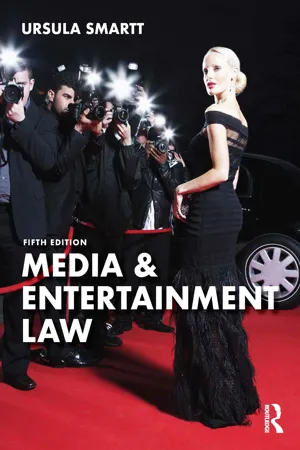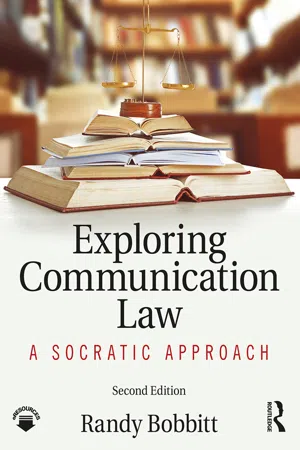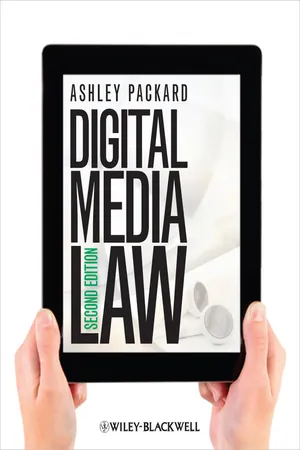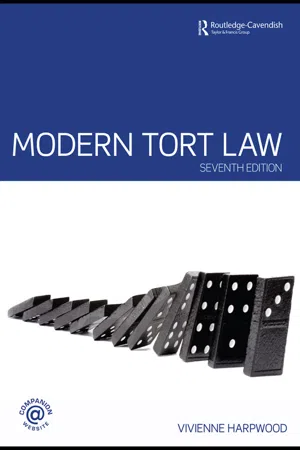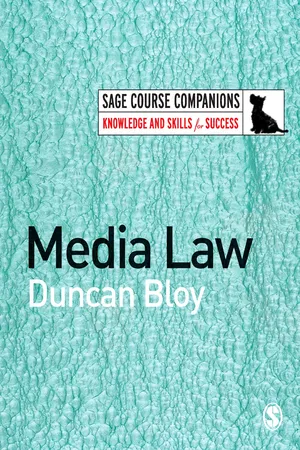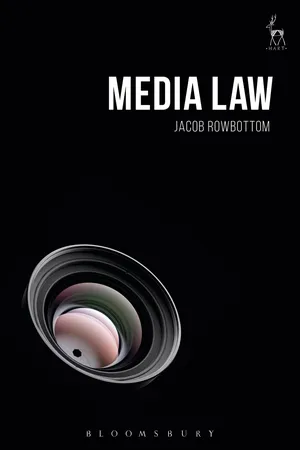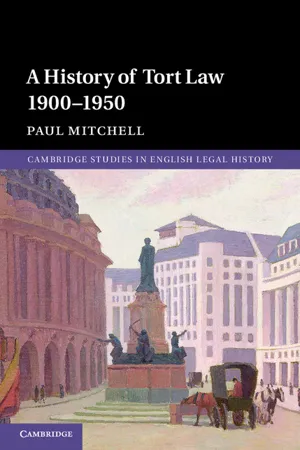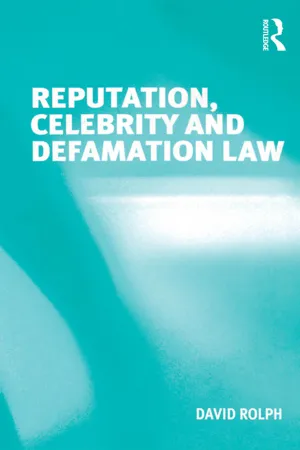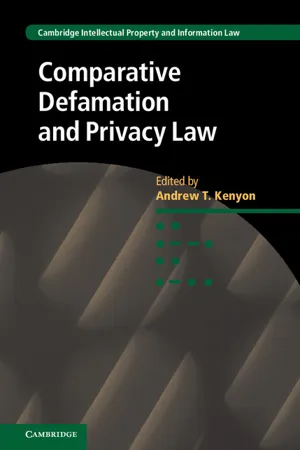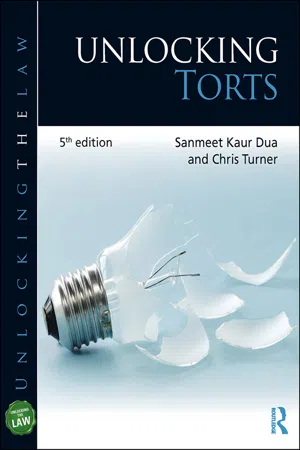Law
Defamation
Defamation refers to the act of making false statements that harm a person's reputation. It encompasses both slander (spoken defamation) and libel (written defamation). To prove defamation, the plaintiff must demonstrate that the statement was false, caused harm, and was made without adequate research or with malicious intent. Defamation laws vary by jurisdiction, but generally aim to protect individuals from unjust damage to their reputation.
Written by Perlego with AI-assistance
Related key terms
1 of 5
11 Key excerpts on "Defamation"
- eBook - PDF
- Douglas Maule, Zhongdong Niu(Authors)
- 2014(Publication Date)
- EUP(Publisher)
WHAT IS Defamation? Defamation is a delict and therefore forms part of the civil law. Actions for Defamation are pursued through the civil courts and damages can be awarded not only for injury to the reputation but also for the insulting nature of the communication. In Scotland, no distinction is made between statements that are spoken and those that are in a permanent form. However, in England the former is termed “slander” and the latter “libel”. It is still possible to be prosecuted for criminal libel in England, although such prosecutions have now virtually disappeared. “Defamation” is defined in the Stair Memorial Encyclopaedia (vol 15, para 470) as: “the making of a statement or communication of an idea concerning the pursuer that is both false and defamatory and is made maliciously, to the pursuer’s loss, injury or damage”. In order for an action to succeed, the statement must be: (1) untrue; (2) communicated and refer to the pursuer; (3) defamatory; and (4) made maliciously, to the pursuer’s loss, injury or damage. It is, however, necessary for the injured party to prove only that the state-ment was defamatory and that it was communicated, as the other two requirements are presumed. What is a defamatory statement? Whether a statement is defamatory or not is a question of law and not fact. The test was first set out in Russell v Stubbs (1913) and is: “whether under the circumstances in which the writing was published, reasonable men, to whom the publication was made, would be likely to understand it in a libellous sense”. In England, Lord Atkins in Sim v Stretch (1913) posed the question “would the words tend to lower the Plaintiff in the estimation of right-thinking members of society generally?”. 62 MEDIA LAW The test is an objective one and it does not therefore generally matter what the person who made the statement thought the meaning was. - eBook - ePub
- Ursula Smartt(Author)
- 2022(Publication Date)
- Routledge(Publisher)
Descheemaeker, E. (2009) at pp. 603–641.Libel is a wrongful act that concerns the publication of material in writing or some other permanent form. In defending a libel action, the difference between a statement of verifiable fact and one of honest opinion can be crucial. As Lord Atkin defined it:Defamation is a publication of an untrue statement about a person that tends to lower his reputation in the opinion of ‘right-thinking members of the community’.(Sim v Stretch (1936))7See Chapter 3.6In relation to statements made on the internet or via social media, it is now generally accepted that defamatory statements are to be regarded as libel that is publication (see: Smith (Nigel) v ADVFN Plc8 (2010)).97 [1936] 2 All ER 1237 (Lord Atkin).8 ADVFN is the world’s leading private investor website offering stock prices, charts and tools for all major world markets, indices, futures, options, etc.9 [2010] EWHC 3255 (QB).If it is spoken or in some sort of other transient form, it is a slander. In Westcott v Westcott (2009),10 Richard Westcott sought damages for slander and libel as well as an injunction to restrain further publication against his daughter-in-law, the defendant Sarah Westcott, over allegations which she had made about him during an interview with the police. After a heated family argument, Mrs Westcott had telephoned the police and claimed in an oral and written statement that Mr Westcott, her father-in-law, had assaulted her and her baby. But the police decided to take no further action.10 [2009] QB 407; [2009] 2 WLR 838.3.2 Defamation in common law
The tort of Defamation developed through the common law tradition over hundreds of years, periodically being supplemented by statute. Diplock LJ referred to ‘the artificial and archaic character of the tort of libel’ in Slim v Daily Telegraph Ltd. as long ago as the mid-1960s.11 - eBook - ePub
Exploring Communication Law
A Socratic Approach
- Randy Bobbitt(Author)
- 2017(Publication Date)
- Routledge(Publisher)
p.151DefamationChapter 6He who steals my purse steals trash, but he who filches me of my good name robs me of that which not enriches him, but makes me very poor indeed.William ShakespeareOthelloWords, once they are printed, they’ve got a life of their own. Words, once spoken, have a life of their own.Carol BurnettPlaintiff, Burnett v. National Enquirer, 1983Defamation DEFINED Libel vs. SlanderLibel and slander are two categories of a broader legal area called Defamation, a term that refers to damage to a person’s or an organization’s reputation or standing in the community or to exposing a person or organization to public shame, hatred, or ridicule.What’s the difference between libel and slander? You often hear people casually explain the difference by saying that libel is written and slander is spoken. But that’s not a complete definition because Defamation that occurs in a radio broadcast is spoken into a microphone, yet is considered libel because of the size of the audience and the fact that it is transmitted over the airwaves. A more accurate delineation is to say that libel is published or broadcast to a wide audience, while slander is communicated on a personal level and to a smaller audience.Some state laws specify that Defamation that takes place over the broadcast airwaves would be libel if it was read from a prepared script (because it was therefore “premeditated”) but slander if it was ad-libbed. The distinction between libel and slander is not as dramatic as it once was. Many states make no such distinction in their laws and simply have one statute to cover both forms of Defamation, allowing judges and juries to make the distinction in the size of their damage awards. West Virginia, for example, has no statutes referring to libel or slander but instead has an “insulting words” statute that provides a number of examples of Defamation. - eBook - ePub
- Ashley Packard(Author)
- 2012(Publication Date)
- Wiley-Blackwell(Publisher)
9 DefamationAround the world, countries balance protections for freedom of expression and reputation differently. The United States, which protects freedom of speech and press in the Constitution, tips the balance in favor of expression. Reputation is still considered worthy of protection but must give way if society’s need for information is more pressing. This policy choice is evident in the Supreme Court’s decision to impose First Amendment constraints on state Defamation laws.Unlike other nations, the United States no longer imposes strict liability upon libel defendants. The Supreme Court has created “a zone of protection for errors of fact” that inevitably occur in publication.1 Plaintiffs who sue for Defamation regarding a matter of public concern must prove negligence or malice on the part of the defendant, as well as the falsity of the defendant’s statements. The United States is also unique in allowing plaintiffs to sue defendants for libel in only one jurisdiction, regardless of how widely the Defamation was published. As a result, media have more protection against Defamation in the United States than any other country in the world.This chapter discusses the elements required to establish a libel claim and defenses that apply in libel suits. It describes how U.S. Defamation law differs from that of other countries and the impact that difference has had on the way various types of plaintiffs are treated. Just as importantly, it explains how libel laws apply to traditional media defendants v. nontraditional or non-media defendants in a period in which we are all producing digital media products. Finally, it considers the tort of infliction of emotional distress and its relationship to Defamation law.What is Defamation?
Defamation is a tort regulated through state law that involves harm to someone’s reputation. It occurs when a false communication exposes a person to hatred, contempt, or ridicule, or lowers a person’s stature in the community.2 - eBook - ePub
- V.H. Harpwood(Author)
- 2009(Publication Date)
- Routledge-Cavendish(Publisher)
Derbyshire CC v Times Newspapers Ltd [1993] AC 534, the House of Lords held that local authorities do not have a right at common law to maintain a claim for Defamation. The decision was explained by Lord Keith in these terms:The Court of Appeal had held that to allow a local authority to sue for libel would greatly inhibit freedom of speech and would be contrary to Art 10 of the European Convention on Human Rights. Individual officers of a local authority would be able to sue in their own right for libel and local authorities are at present able to rely on criminal libel.It is of the highest public importance that a democratically elected governmental body, or indeed any governmental body, should be open to uninhibited public criticism. The threat of a civil action for Defamation must inevitably have an inhibiting effect on freedom of speech.18.4 A WORKING DEFINITION OF Defamation
This definition will be examined in detail to identify and explain the various elements of the tort.Whether a statement amounts to libel or slander it must satisfy the general requirements of the law to be actionable. A useful starting point is a definition of Defamation which is as follows: Defamation consists of publishing a defamatory statement which refers to an identifiable claimant, without lawful justification.18.4.1 Publication
The statement must be published to a person other than the claimant alone. It is not actionable in civil law merely to make a defamatory statement to the claimant alone out of ear-shot of a third person, nor to write a letter to the claimant containing defamatory material. If the claimant decides to show a potentially defamatory letter to someone else, there is a defence of volenti as the claimant, not the defendant, has published the statement.In Hinderer v Cole - eBook - PDF
- Duncan Bloy(Author)
- 2006(Publication Date)
- SAGE Publications Ltd(Publisher)
In October 2005, Rupert Lowe, Chairman of Southampton Football Club, was awarded £250,000 in damages after The Times accused him of treating a former manager of the club ‘shabbily’. In May 2006, the jury in Purnell v. Business F1 Magazine awarded the claimant £75,000, despite Gray J advising them that the award ought to have been in the region of £25,000–£60,000. Definition of Defamation Perhaps the definition quoted most often is that given by Lord Atkin in the House of Lords in the case of Sim v. Stretch [1936] 2 All ER 1237. This, or a variation on it, has seemingly been quoted in almost every defama-tion action since then. He said that Defamation is: A statement which tends to lower the claimant in the estimation of right-thinking members of society generally, and in particular to cause him to be regarded with feelings of hatred, contempt, ridicule, fear and disesteem. MEDIA LAW 64 The Faulks Committee on Defamation in 1975 came up with something similar: Defamation shall consist of a publication to a third party of matter which in all the circumstances would be likely to affect a person adversely in the estimation of reasonable people generally. The critical question is whether or not the words referred to in a case are capable of carrying the defamatory meaning alleged. A case that is often cited to help answer this question is Gillick v. British Broadcasting Corporation [1996] EMLR 267. In the judgement for this case the law was summarised thus: • the court should give to the material complained of the natural and ordinary meaning that it would have conveyed to the ordinary reasonable viewer watch-ing the programme • the hypothetical reasonable reader or viewer is not naive, nor unduly suspicious – he can ‘read between the lines’; he can read in an implication but must not be treated as a man who is avid for scandal • the court should be cautious of an over-elaborate analysis of the material issue and should not take too literal an approach. - No longer available |Learn more
- Jacob Rowbottom(Author)
- 2018(Publication Date)
- Hart Publishing(Publisher)
69 Ley v Hamilton (1935) 153 LT 384 at 386. For criticism, see Barendt, ‘What is the Point of Libel Law?’ (n 21) 123–24. 70 Thornton v Telegraph Media Group Ltd [2010] EWHC 1414 (QB), [2011] 1 WLR 1985 at [96]. the eyes of a religious organisation, but one would not say that it lowers the reputa-tion in the eyes of right-thinking people more generally. However, if that statement was made about someone who claims to be a devout Christian, then an argument can be made that the false statement is defamatory in so far as it implies a level of hypocrisy. By taking this step, the court can look at the statement in its context and differentiate between particular individuals, the community to which they belong and the reputation they hold. iv. Damage To say that a statement is defamatory means that it is likely to have a particular effect on the mind of the audience (by lowering the person in their estimation). The right to reputation could thereby raise questions of media effects, namely whether it is possible to prove that a statement is likely to have such an impact. Prior to the Defamation Act 2013, the court avoided such issues by placing itself in the position of the reason-able person and asking how it would react to the statement. Once the court decided the statement would tend to have the effect of lowering a person’s estimation in the eyes of the reasonable person, the traditional rule was to presume that the defamatory state-ment caused actionable damage. 67 As a result, a person could bring an action against a publisher even if he or she could not prove that any harm had been suffered as a consequence of the defamatory statement. The rule was sometimes justified on the basis that the imputation of wrongdoing or of other discreditable conduct is the principal injury and that the effects (such as loss of social and professional opportunities) are consequent losses. - eBook - PDF
- Paul Mitchell(Author)
- 2015(Publication Date)
- Cambridge University Press(Publisher)
A Defamation, whether committed by word of mouth, 6 in writing (picture, letter, poster), 7 over the wireless 8 or by producing a cine- matographic picture 9 is subject to the criteria discussed above, which deter- mine whether it is of an aggravated character or not. Thus there is no room for the English concept of damage per se. On the other hand, since every defama- tory statement, with the exception of those of a very minor and private charac- ter, are punishable with a fine or even with imprisonment, it may be suggested, with some diffidence, that in continental law practically all Defamations are Defamations per se, p. 5 although in a different sense than in English law (of damages see below). The various types of Defamation are determined by the criteria set out above. In Germany the principal distinction is whether the defamatory statement 5 Florian, Ingiuria e diffamazione, Milan (2.ed.1939), p.153. 6 Barbier, Code expliqué de la Presse p.437, no.441; p.225, no.243; p.280, no.277. 7 Florian, p.115, note 3. 8 Barbier, Suppl. (1938), p.47 no.255 bis Trib. Corr. Bourges, 19/7/1934. D.P. 1934 1.121; 9 Trib. Dijon. 5/5/1935. D. Hebd. 1935, p.437; App. Dijon. 8/1/1936; D.P. 1936.1.29; Gaz. Pal. 1936, 1 p.339; Barbier, Suppl. p.48 no. 257 bis; p.111, no.814; Florian, p.115 note 2. Appendix: Lipstein and Gutteridge on Defamation 336 recites facts which are untrue, or whether it is merely insulting. The former (üble Nachrede par. 186 of the Criminal Code) is made to third parties; the latter (Beleidigung, art. 185 of the Criminal Code) is directed against the defamed person, who must be present. If the untrue statement is made mali- ciously, with full knowledge that it is unfounded, it falls into a separate cat- egory (Verleumdung, art. 187). The penalties are lowest for insults, higher for simple Defamations, and highest in the case of aggravated Defamations. In France 10 the same distinction is drawn as in Germany. - eBook - ePub
- David Rolph(Author)
- 2016(Publication Date)
- Routledge(Publisher)
Meaning, Publication, Identification and DamagesDOI: 10.4324/9781315605524-3Introduction
Historically, then, there have been different reputational interests afforded protection by Defamation law. Accordingly, it is unsurprising that the basic principles of liability for Defamation law also embody different concepts of reputation. In subsequent chapters, the ways in which these concepts of reputation manifest themselves in practice will be analysed through a series of case studies. However, as the essential background to these case studies, it is necessary to examine the principles underpinning liability for Defamation – namely, defamatory capacity and meaning; identification; and publication. This chapter will examine those principles and will also explore the purposes for which Defamation damages are awarded. The focus of this chapter will not be solely on the elucidation of the relevant principles but more particularly on how these principles themselves manifest and reinforce competing concepts of reputation.Defamatory Capacity and Meaning1
1 As to the issue of defamatory capacity and meaning generally, see Tobin and Sexton 1991 , [3001]ff; Carter-Ruck and Starte 1997, Ch. 4; Gillooly 1998 , Ch. 3; Milmo and Rogers (eds) 2004, Chs 2 and 3; Price and Duodu 2004 , 2-13-2-23; George 2006 , Ch. 9.In order for a defendant to be held liable for the publication of a matter, a judge must find that the matter is capable of conveying a defamatory meaning of and concerning the plaintiff and a jury must find that the matter does in fact convey a defamatory meaning.2 The questions of defamatory capacity and meaning are therefore the first threshold of liability for Defamation. As Walker has emphasised, it is important to distinguish between the tests for defamatory meaning and the concept of reputation (Walker 2000 - eBook - PDF
- Andrew T. Kenyon(Author)
- 2016(Publication Date)
- Cambridge University Press(Publisher)
This chapter examines the Defamation standards recently adopted in the US, UK and Australia, and offers some reflection on the efficacy of those standards in terms of promoting free speech and democratic values. 5.1 The common law of Defamation The common law of Defamation was decidedly pro-plaintiff, and erred decisively in favour of reputation over freedom of expression. Without attempting to summarise fully the common law, something that would be difficult or impossible in the context of a short chapter, the English common law of Defamation was decidedly pro-plaintiff, 24 and saddled plaintiffs with only limited burden of proof obligations. 25 Although English law provided various privileges to defendants, 26 including the 21 See Stanton D Krauss, ‘An Inquiry into the Right of Criminal Juries to Determine the Law in America’ (1998) 89 Journal of Criminal Law & Criminology 111, 183 n 290. 22 See New York Times v. Sullivan, 376 US 254 (1964); see also C Edwin Baker, ‘Scope of the First Amendment Freedom of Speech’ (1978) 25 UCLA Law Review 964; Robert H Bork, ‘Neutral Principles and Some First Amendment Problems’ (1971) 47 Indiana Law Journal 1; Thomas I Emerson, ‘Toward a General Theory of the First Amendment’ (1963) 72 Yale Law Journal 877; Alexander Meiklejohn, ‘The First Amendment is an Absolute’ [1961] Supreme Court Review 245; Russell L Weaver, Understanding the First Amendment, 5th edn (New Providence, NJ: LexisNexis, 2014) 10–3. 23 See New York Times v. Sullivan, 376 US 254 (1964). 24 See Weaver et al., above n 7, at 17. 25 Ibid., at 21–5 (e.g., plaintiff must show that the material was ‘published’, that the material identified him or her, and that the publication carried a defamatory meaning). 26 Ibid., at 31–4. 84 Russell L. Weaver defence of ‘fair comment’, 27 the burden of proving ‘truth’ rested squarely on the defendant. - eBook - ePub
- Sanmeet Kaur Dua, Chris Turner(Authors)
- 2019(Publication Date)
- Routledge(Publisher)
Slander generally Case/statute Untrue statement in transient form. Usually verbal but can be gesture. Traditionally special damage required but with some exceptions. Elements of Defamation Case/statute Statement must be defamatory. The statement must have caused or be likely to cause serious harm to the claimant’s reputation (or some financial loss in the case of a body trading for a profit). Lachaux v Independent Print Ltd [2019] UKSC 27 Monroe v Hopkins [2017] EWHC 433 It must refer to claimant. s1 Defamation Act 2013 It must be published. It must be false. Meaning of defamatory Case/statute Statement is untrue. Cassell v Broome [1972] It tends to lower a person in the eyes of others Parmiter v Coupland [1840] Youssoupoff v MGM [1934] or to expose them to ridicule or contempt. Byrne v Deane [1937] or to cause others to shun them. Hartt v Newspaper Publishing [1989] Note problem of deciding who is ‘right-thinking member of society’: Cassidy v Daily Mirror [1929]; Tolley v Fry & Sons [1931]; Norman v Future Publishing [1999]•
Index pages curate the most relevant extracts from our library of academic textbooks. They’ve been created using an in-house natural language model (NLM), each adding context and meaning to key research topics.

